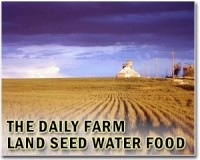 |
Madison WI (SPX) Aug 19, 2010 Fields amended with poultry litter can accumulate significant levels of arsenic, according to studies by USDA-Agricultural Research Service (ARS) scientists and associates. These findings provide key information about the agricultural pollutants that can build up in agricultural soils over time-and possibly migrate into nearby streams and rivers. Poultry producers have sometimes supplemented chicken feed with roxarsone, a compound containing arsenic, to control parasites and promote weight gain. Most of this arsenic is excreted by the birds and then becomes mixed in with sawdust and other litter materials used in poultry houses. Farmers typically use the litter as a nutrient-rich-and free-fertilizer for amending their crop soils. Chemist Clinton Church, who works at the ARS Pasture Systems and Watershed Management Research Unit in University Park, Pa., led this research. His partners included University Park soil scientist Peter Kleinman, support scientist Lou Saporito, research leader Ray Bryant and University of Maryland Eastern Shore scientist Arthur Allen. For two years, the team measured arsenic levels in runoff that flowed from farm fields into seven drainage ditches in the Delmarva (Delaware, Maryland, Virginia) Peninsula, an area dominated by large-scale poultry production for decades. Runoff measurements indicated that annual arsenic losses from these fields could range from 0.004 kilograms per hectare to 19 kilograms per hectare. Runoff with the largest arsenic loads was recorded in a ditch closest to a main point source of the contaminant-a shed where litter was stored. They team also tracked phosphorus runoff, as it are known to interact and compete with arsenic. During storm events, both pollutants exhibited similar behavior. However, their concentrations differed significantly between ditches and showed no seasonal patterns. This suggests that management practices for phosphorus are unlikely to be applicable to arsenic. This study highlights the importance of controlling point sources of arsenic and other chemicals and suggests that management practices-such as properly storing dry litter and controlling litter spills outside storage facilities-can help protect local regions from the migration of arsenic and other agricultural pollutants.
Share This Article With Planet Earth
Related Links American Society of Agronomy (ASA) Farming Today - Suppliers and Technology
 Ukraine to limit grain exports due to drought: official
Ukraine to limit grain exports due to drought: officialKiev (AFP) Aug 17, 2010 Ukraine is impose a cap on wheat and barley exports until the end of the year due a severe drought, officials said on Tuesday, after a full ban by Russia triggered concern on global grain supplies. Ukraine will export a maximum of 3.5 million tonnes of wheat and barely until the end of the calendar year, the agriculture ministry said, barely half of what it exported last year in the same sea ... read more |
|
| The content herein, unless otherwise known to be public domain, are Copyright 1995-2010 - SpaceDaily. AFP and UPI Wire Stories are copyright Agence France-Presse and United Press International. ESA Portal Reports are copyright European Space Agency. All NASA sourced material is public domain. Additional copyrights may apply in whole or part to other bona fide parties. Advertising does not imply endorsement,agreement or approval of any opinions, statements or information provided by SpaceDaily on any Web page published or hosted by SpaceDaily. Privacy Statement |